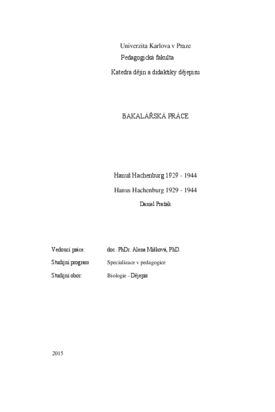Hanuš Hachenburg 1929 -1944
Hanus Hachenburg 1929 -1944
bakalářská práce (OBHÁJENO)

Zobrazit/
Trvalý odkaz
http://hdl.handle.net/20.500.11956/65127Identifikátory
SIS: 128860
Katalog UK: 990020025890106986
Kolekce
- Kvalifikační práce [20518]
Autor
Vedoucí práce
Oponent práce
Koura, Petr
Fakulta / součást
Pedagogická fakulta
Obor
Biologie, geologie a environmentalistika se zaměřením na vzdělávání - Dějepis se zaměřením na vzdělávání
Katedra / ústav / klinika
Katedra dějin a didaktiky dějepisu
Datum obhajoby
26. 5. 2015
Nakladatel
Univerzita Karlova, Pedagogická fakultaJazyk
Čeština
Známka
Výborně
Klíčová slova (česky)
Terezín, holocaust, Osvětim, poezie, Vedem, Hanuš HachenburgKlíčová slova (anglicky)
Theresienstadt, holocaust, Auschwitz, poetry, Vedem, Hanuš HachenburgTato práce se věnuje osudu židovského básníka Hanuše Hachenburga, který byl ve svých 14 letech zavražděn v plynové komoře v Osvětimi-Březince. Ve své první části práce mapuje jeho život od jeho nejasného dětství s rodiči, života v sirotčinci a transportu do Terezína až do pobytu v Osvětimi-Březince. Na život v Terezíně bude brán větší zřetel, zejména s ohledem k jeho tvorbě v chlapeckém časopise Vedem. V závěru této části je popsán život v Terezínském rodinném táboře a jeho fungování. Druhá část práce je věnována druhému životu Hanuše Hachenburga. Autor v ní popisuje projekty a jejich výsledky, které se věnovaly osobě Hanuše Hachenburga v posledních pěti letech. KLÍČOVÁ SLOVA Terezín, holocaust, Osvětim, poezie, Vedem, Hanuš Hachenburg
This work is focused on the fate of the Jewish poet Hanuš Hachenburg, who was murdered in a gas chamber in Auschwitz-Birkenau at the age of fourteen. In the first part, the work maps his life from his unclear childhood, first with parents and later his life in the orphanage, to the transport to Theresienstadt and the stay in Auschwitz - Birkenau. The part of his life spent in Theresienstadt will be dealt with in detail, particularly concerning his literary work for the boys' magazine Vedem. At the end of this part, the living conditions in the Theresienstadt family camp and its organization are described. The second part of the work deals with the second life of Hanuš Hachenburg. The author describes numerous projects, together with their results, dedicated to the person of Hanuš Hacheburg in the last five years. KEYWORDS Theresienstadt, holocaust, Auschwitz, poetry, Vedem, Hanuš Hachenburg
